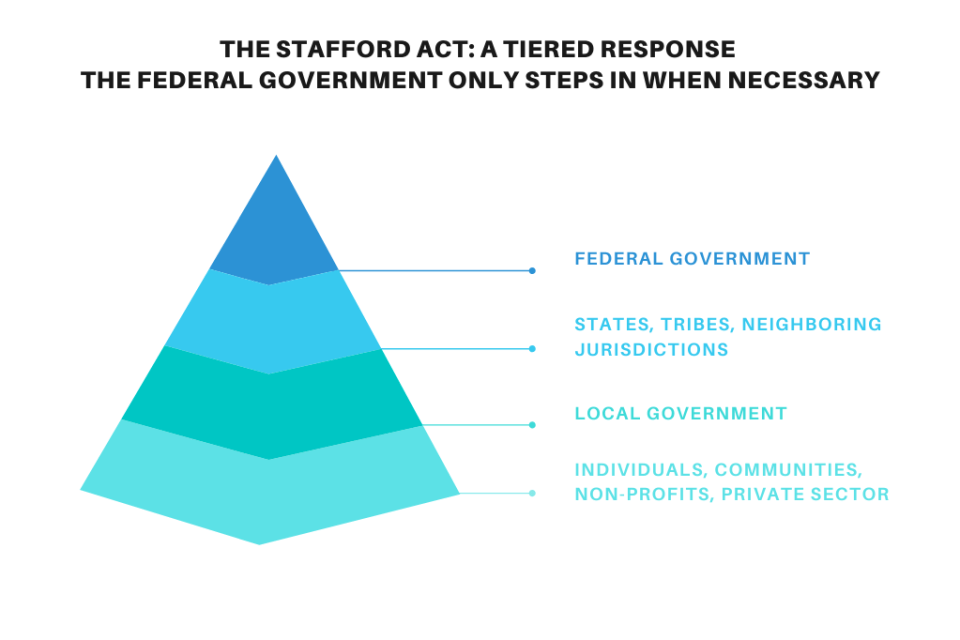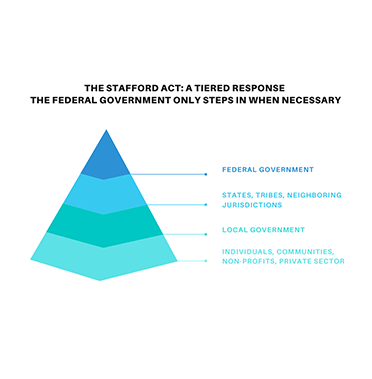About the Stafford Act
The Robert T. Stafford Disaster Relief and Emergency Assistance Act (Stafford Act) from 1988 is a U.S. Federal law designed to guide how the Federal Emergency Management Agency (FEMA) manages disaster assistance for State and local governments in protecting their communities. The Stafford Act is intended to encourage States and localities to develop comprehensive disaster preparedness plans, prepare for better intergovernmental coordination in the face of a disaster, encourage the use of insurance coverage, and provide Federal assistance programs for losses due to a disaster. Today, the Stafford Act is the primary guidance that helps establish the objectives of FEMA concerning preparedness and disaster recovery, sets the bounds and guardrails of its programs, and establishes the legal authority and process for the Federal government to aid States and Tribes during major disasters and emergencies.
The Federal approach
Devastating natural hazard events such as the Dust Storms and Floods in the 1920s and 1930s led the U.S. Federal government to support localities more actively with disaster recovery. Today, the U.S. Federal government maintains a “limited intervention model,” meaning it does not cover the entire cost of recovery or every disaster in the U.S. This model requires that State, Tribal, and local governments take the initiative to prepare their residents, housing, and infrastructure for disaster events and make best efforts to respond in the event of an emergency. The Federal government steps in only when the State or Tribe is overwhelmed and needs support.

What the Stafford Act does
- Revises and broadens the scope of existing disaster relief programs.
- Encourages the development of comprehensive disaster preparedness and assistance plans and programs by States and by local governments.
- Helps achieve greater coordination and responsiveness of disaster preparedness and relief programs.
- Encourages individuals, States, and local governments to protect themselves by obtaining insurance coverage to supplement or replace governmental assistance.
- Mandates that every local jurisdiction, State, and Tribal government create a Hazard Mitigation Plan every 5 years (an important plan that documents how a locality will reduce potential risks by taking actions before disasters).
- Supports hazard mitigation measures to reduce losses from disasters, including developing land use and construction regulations and providing Federal assistance programs for both public and private losses sustained in disasters.
- It prevents “Duplications of Benefits” when multiple funding sources pay for the same good or service, such as new clothes or home repairs. Recovery assistance may come from many sources, including income from insurance, FEMA grants, SBA loans, other federal, state, or local sources, private loans, lines of credit, etc. The Stafford Act requires all recipients and sub-recipients of funding to prove that they are not duplicating funds. While this helps to make sure there is funding for all, it also adds administrative hurdles.
What the Stafford Act does not do
- Define what “resilience” and “mitigation” are for a particular community. All communities need to define their own mitigation and adaptation plans and ensure that funding and resources are provided per community priorities.
- Provide all the funding needed by communities to recover housing, infrastructure, and social services after an event. Communities need to map out what resources are available to support recovery.
- Enable FEMA to rebuild permanent housing and infrastructure to ensure that the community has continuity of services and housing. This is where partnerships with the Department of Housing and Urban Development via the CDBG-DR program are important to help bridge the gap between temporary to permanent housing, infrastructure, and service needs.
- Guarantee money for Hazard Mitigation Planning, although funding is available via the competitive BRIC program. Many jurisdictions do not have the funding or capacity to engage in mitigation planning.
Impacts on frontline communities
The Federal government does not cover the entire cost of response and recovery, nor the cost of preparing for disasters. Most States, Tribes, or localities must share the cost and responsibility of preparing and recovering from a disaster in partnership with the Federal government. Individuals and households are also expected to have some means of response and recovery, including insurance or savings to help cover costs. Unfortunately, frontline communities often cannot afford insurance or keep an emergency fund that would be sufficient to recover from a disaster.
Reforms to the Stafford Act: The Disaster Recovery Reform Act of 2018 (DRRA)
In 2018, Congress passed, and the President signed the Disaster Recovery Reform Act (DRRA), which made a series of important reforms to the Stafford Act.
- The new law allows the President to set aside up to six percent of the amount appropriated to FEMA’s disaster relief fund for pre-disaster mitigation for public infrastructure. This is a dramatic increase in mitigation funding. This change launched the BRIC program, which is a competitive grant process for mitigation funds.
- The DRRA also gives new authority to rebuild buildings according to the latest building codes and increase resiliency to current and future hazards, including sea-level rise and drought.
Action to take to work with the Stafford Act
For community-based organizations and affordable housing providers
- Since the Stafford Act does not reimburse communities for 100% of costs on most activities, seek out ways to fully fund recovery in advance of the event.
- Create or build on mutual aid support networks that exist in your community to support individuals and households with their needs after a disaster in ways that will fill in gaps in Federal funding.
- Consider advocating for further improvements to Federal disaster policy, like the Stafford Act, to ensure there is sufficient Federal support for mitigation planning, resiliency building, and preparedness as well as post-disaster recovery and rebuilding.
For local government
- Work with community-based organizations to develop a plan for combining different financial resources (from government, philanthropy, etc.) to complement Federal support and lead to full recovery and rebuilding.
- Having a Hazard Mitigation Plan is key to reducing impacts. Engage with frontline communities in creating a plan that meets their needs.
- Apply for BRIC funding to engage in hazard mitigation planning and mitigation activities.
- Work with community-based organizations to get more households insured.
For philanthropy
- Work with community-based organizations to determine the gaps that Federal funding will leave in preparing for and mitigating disaster and providing recovery money for frontline communities. These gaps always exist for people without insurance and for people who are undocumented.
- Support hazard mitigation planning, especially in small, rural jurisdictions, and provide funding support and/or technical assistance to help communities prepare for disaster and mitigate impacts on housing and infrastructure.
- Invest in pilot programs to demonstrate creative solutions to mitigation and adaptation of risk.

- Toolkit